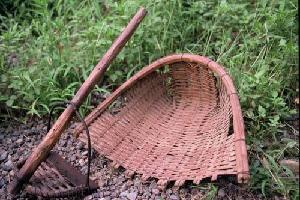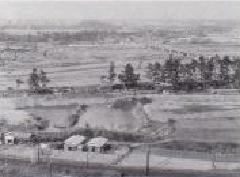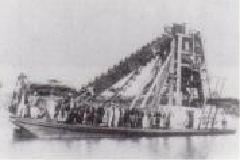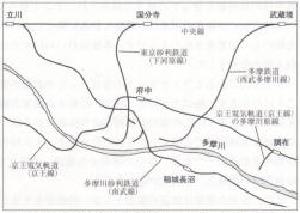Last updated: June 28, 2017
Gravel mining in the Tama River basin has been carried out since the Edo period, and records show that the gravel was sold as money to be sent to the shogunate. However, it began in earnest in the mid-Meiji period, when river gravel was scooped up using joren, transported using gravel winnows, sorted using metal sieves, and transported to the Tokyo area. This was before the introduction of large excavating and sorting machines, and all gravel extraction was done by hand, giving rise to the term "Tama River gravel sieve." In addition, the gravel collected in the downstream area was transported to Rokugo using wooden gravel boats with sails, where it was reloaded and shipped throughout Tokyo. Around the Meiji period, river gravel was mostly used as ballast for roads and railways, and it seems that large-grained gravel was required. In villages along the Tama River, gravel sifting became a source of cash income for farmers.
In the Taisho period, its use as aggregate for concrete became popular, and gravel from the Tama River was also used. Especially after the Great Kanto Earthquake of 1923, the production of river gravel rapidly increased due to reconstruction demand. At this time, the center of gravel mining on the Tama River was in the middle reaches from Tachikawa to Inagi. This is because the downstream area is already occupied. From around the end of the Taisho era, large excavators and mechanical ships began to be used, making it possible to perform all operations from gravel mining to sorting and cleaning all at once, leading to the mechanization and rationalization of the gravel industry. has progressed.
The extraction of gravel was also closely related to the construction of railways. The following is a list of railways built for the purpose of collecting and transporting gravel in the area around Inagi.
The Tamagawa Gravel Railway (later Nambu Line) was established in 1920 and opened between Kawasaki and Daimaru in 1927, and between Chofu and Tamagawara in 1916. The Tamagawara Line of the Keio Electric Tramway (later the Keio Line), which began operation in 1922, and the Tama Railway, which opened from Musashisakai to Koremasa on the Chuo Line in 1922. These include the Tokyo Gravel Railway (JNR Shimogawara Line), which began operating between Kokubunji and Shimogawara in 1910 (later known as the Seibu Tamagawa Line). Looking at when they were laid, all of them were constructed in just 20 years, from the end of the Meiji period to the beginning of the Showa period, and these railways were already completed in 1929. It will be. Looking at the location of the railways that have been built, we can see that the main lines are the Nambu Line, Keio Line, and Chuo Line, with branch lines branching out in a fishhook shape toward the Tama River. You can see how it is stretching.
With the mechanization of gravel mining and the realization of mass transportation through the construction of railways, gravel mining from the Tama River reached its peak from the end of the Taisho era to the early Showa era. However, large quantities of gravel mining have various negative effects on the Tama River itself. These include destruction of seawalls, difficulty in obtaining water for agricultural use due to lowered riverbeds, and negative effects on fisheries due to water pollution. In response to this, from 1930 onwards, mining on high water banks was not permitted in areas upstream from Futakobashi Bridge and downstream from Hinobashi Bridge. As a result, only low water beds were allowed.
After the war, post-war reconstruction gradually progressed in the 1940s, and gravel mining in the Tama River began to regain its pre-war activity. However, as gravel pollution due to over-digging progressed, the Tama River downstream from Hino Bridge was concluded with the Tama River Gravel Collection Control Agreement in 1958, and regulations were tightened. In the 1950s, regulations were further tightened, and in 1960, commercial mining was completely prohibited up to Mannenbashi Bridge in Ome City. The following year, in 1965, gravel mining was completely banned throughout the entire Tama River, and the history of gravel mining came to an end.
References cited. “Inagi City History Volume 2”
“Folklore of Inagi City (4)” “Inagi Things and Life 3”

Gravel winnow and jolen used for gravel mining

A gravel mining hole in Daimaru (photographed by Hideo Hamada in 1964)

A machine ship for gravel mining (around the end of the Taisho era)

Deterioration of the riverbed due to over-digging (1988)

Gravel railway around Inagi in the early Showa period
Inagi City Education Department Lifelong Learning Division Tel: 042-377-2121